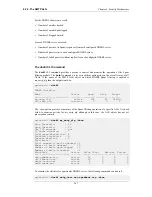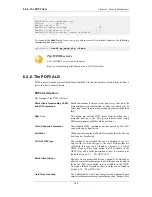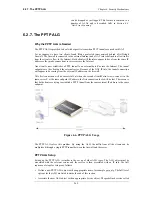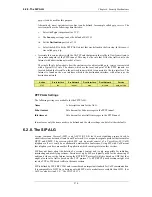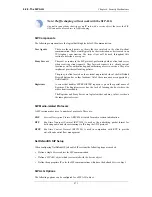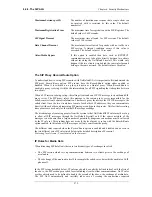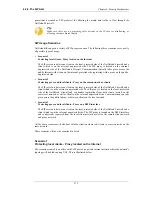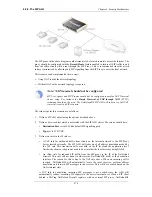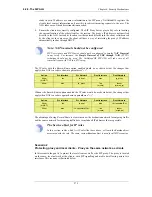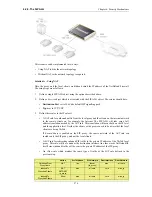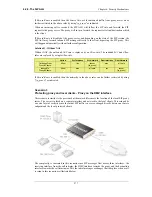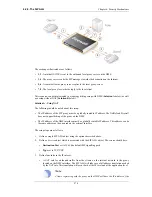
Logging
There are three types of logging done by the Spam filtering module:
•
Logging of dropped or Spam tagged emails - These log messages include the source email
address and IP as well as its weighted points score and which DNSBLs caused the event.
•
DNSBLs not responding - DNSBL query timeouts are logged.
•
All defined DNBSLs stop responding - This is a high severity event since all email will be
allowed through if this happens.
Setup Summary
To set up DNSBL Spam filtering in the SMTP ALG, the following list summarizes the steps:
•
Specify the DNSBL servers that are to be used. There can be one or multiple. Multiple servers
can act both as backups to each other as well as confirmation of a sender's status.
•
Specify a weight for each server which will determine how important it is in deciding if email is
Spam or not in the calculation of a weighted sum.
•
Specify the thresholds for designating any email as Spam. If the weighted sum is equal or
greater than these then an email will be considered to be Spam. Two thresholds are specified:
i.
Spam Threshold - The threshold for tagging mail as spam.
ii.
Drop Threshold - The threshold for dropping mail.
The Spam Threshold should be less than the Drop Threshold. If the two are equal then only the
Drop Threshold applies.
•
Specify a textual tag to prefix to the Subject field of email designated as Spam.
•
Optionally specify an email address to which dropped email will be sent (as an alternative to
simply discarding it). Optionally specify that the TXT messages sent by the DNSBL servers that
failed are inserted into the header of these emails.
Caching Addresses for Performance
To speed processing NetDefendOS maintains a cache of the most recently looked-up sender "From"
addresses in local memory. If the cache becomes full then the oldest entry is written over first. There
are two parameters which can be configured for the address cache:
•
Cache Size
This is the number of entries that the cache can contain. If set to zero, the cache is not used.
Increasing the cache size increases the amount of NetDefendOS memory required for
Anti-Spam.
•
Cache Timeout
The timeout determines how long any address will be valid for once it is saved in the cache.
After this period of time has expired, a new query for a cached sender address must be sent to
the DNSBL servers.
The default value if 600 seconds.
The Anti-Spam address cache is emptied at startup or reconfiguration.
6.2.5. The SMTP ALG
Chapter 6. Security Mechanisms
266
Summary of Contents for DFL-1600 - Security Appliance
Page 27: ...1 3 NetDefendOS State Engine Packet Flow Chapter 1 NetDefendOS Overview 27 ...
Page 79: ...2 7 3 Restore to Factory Defaults Chapter 2 Management and Maintenance 79 ...
Page 146: ...3 9 DNS Chapter 3 Fundamentals 146 ...
Page 227: ...4 7 5 Advanced Settings for Transparent Mode Chapter 4 Routing 227 ...
Page 241: ...5 4 IP Pools Chapter 5 DHCP Services 241 ...
Page 339: ...6 7 Blacklisting Hosts and Networks Chapter 6 Security Mechanisms 339 ...
Page 360: ...7 4 7 SAT and FwdFast Rules Chapter 7 Address Translation 360 ...
Page 382: ...8 3 Customizing HTML Pages Chapter 8 User Authentication 382 ...
Page 386: ... The TLS ALG 9 1 5 The TLS Alternative for VPN Chapter 9 VPN 386 ...
Page 439: ...Figure 9 3 PPTP Client Usage 9 5 4 PPTP L2TP Clients Chapter 9 VPN 439 ...
Page 450: ...9 7 6 Specific Symptoms Chapter 9 VPN 450 ...
Page 488: ...10 4 6 Setting Up SLB_SAT Rules Chapter 10 Traffic Management 488 ...
Page 503: ...11 6 HA Advanced Settings Chapter 11 High Availability 503 ...
Page 510: ...12 3 5 Limitations Chapter 12 ZoneDefense 510 ...
Page 533: ...13 9 Miscellaneous Settings Chapter 13 Advanced Settings 533 ...
















